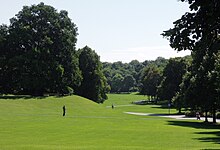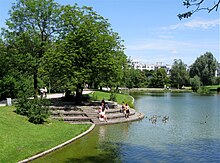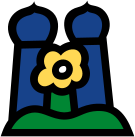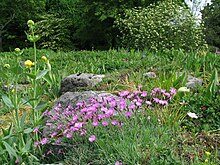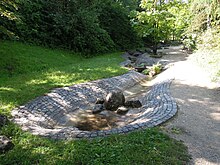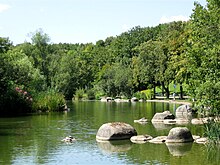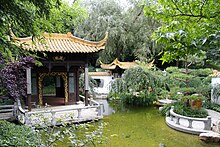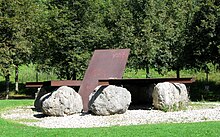Westpark (Munich)
The West Park is a park in Munich district Sendling-Westpark . It was created for the International Horticultural Exhibition (IGA) in 1983 and has been freely accessible since its end. After an extension, the West Park is 69 hectares in size with an east-west extension of around 2.4 kilometers. It is divided by the Mittlerer Ring ( Garmischer Straße ) into an east and a west section, which are connected by a green, wide pedestrian and bicycle overpass.
The park's leisure facilities include playgrounds and sports fields, barbecue facilities, two beer gardens , a restaurant, and walking and cycling paths. Flower and perennial gardens, an alpine garden , a rose garden , a historical garden, a garden for the blind , the East Asian ensemble with gardens and buildings as well as other national gardens are attractions for visitors and make the Westpark the most popular urban park in Munich. Furthermore, the park has been the location of several important works of art in public spaces since the horticultural exhibition .
history
In the 1970s, the area of the later West Park was around 60 hectares of largely undeveloped wasteland in what was then the Waldfriedhofsviertel district , which was characterized in the north by the Lindau motorway and its end and confluence with the western Mittlerer Ring. In the east, the area bordered on the premises of a construction company and the railway line to Großhesselohe . In the south, after the Second World War, there were rows of buildings on the main streets , behind them in the south-west single-family houses and in the south-east apartment blocks up to close to the area. In the north, at the end of the motorway, there are sports areas and the Rudi-Sedlmayer-Halle (since 2011 Audi Dome ) built for the Olympic Games in 1972 . In the southwest of the area there was an abandoned gravel works, in the east there were two small commercial areas and a disused cycling track . The area was level and was partly used for agriculture. Except for two old oaks east of the middle ring, the area was treeless.
In the time of National Socialism , the eastern part of the site was intended for the power-through-joy city , a settlement for workers who were to build the monumental buildings on the planned axis from Pasing to the city center. After the Second World War, an extension of the Lindau autobahn as a federal road to Lindwurmstrasse , a large car park for the former exhibition center on Theresienhöhe, and residential and commercial buildings were under discussion. Citizens' initiatives and local politicians turned against this, calling for a park for the heavily built-up districts of Sendling , Laim and the nearby Westend . In preparation for the Olympic Games, Munich had also greatly expanded the supply of residential and commercial space, and when the population stagnated or fell for a short time, around 5,000 apartments in Munich were vacant in 1973, which is why the political pressure to develop building land decreased for a short time.
The urban development plan of 1975 provided for a green network with a new West, East and North Park; the north park near the Freimann district was named in 1973 as the location for a possible application by the city of Munich for the 1983 International Horticultural Exhibition. In 1976 it became apparent that a horticultural exhibition in the Nordpark - because of its location away from densely built-up city districts, without suitable areas for exhibition halls and because of its enormous size - could not expect any funding from the Free State of Bavaria and the federal government. So the idea arose to hold the IGA in Westpark. It was formulated by the city's horticultural department and the Munich city council decided to build the Westpark and apply for the horticultural exhibition.
In the same year, the urban development plan was supplemented by a green and recreational area plan, which represented the planning basis for the Westpark. However, in 1974 building rights with a large number of floor areas were transferred to the southern part of the site for the Bayernwerk company . It stood in the way of the plans and after extensive negotiations, the building rights were relocated to the former municipal coal storage facility on Heckenstallerstraße as part of the West Park planning . This ultimately resulted in the settlement on Gottfried-Böhm-Ring. It was only through the transfer of the building rights, the abandonment of further planning and the purchase of around half of the area from private property by the city that it was possible to use the previous fallow land in full for the Westpark. In the course of the negotiations it emerged that the company premises of the construction company Leonhard Moll, which is adjacent to the future park in the east, with around 14 hectares would be abandoned in the following years and could be used during the exhibition. The city was able to buy part of the area and add it to the park permanently.
draft
In the summer of 1976, an architectural competition for the Westpark was opened. Only Bavarian landscape architects were allowed . The requirements for the park through the planning of the horticultural exhibition were only specified in the course of the competition and had to be incorporated into the ongoing draft planning.
In February 1977, the Munich landscape architect Peter Kluska won the jury's unanimous decision with a design that “attempted [...] to create a valley area shielded from the noise of the big city, with the character of the pre-Alpine landscape , into which the visitor can immerse himself and which is artificially piled up. Morain- like hills from which he can see the cityscape and the alpine panorama. ”According to his own account, the idea came to him when he was taking a bird's eye view of the area to be planned on a flight to Munich. Embedded in the valley structures, in both parts of the park there is a water landscape at the lowest point of the area, which, compared to the Olympic Park, has been described as a “diverse echo of the popular Munich Olympic landscape”. The jury pointed out that "an enhanced landscape experience is offered that is unmistakable in its character".
The path network is an essential part of the park design. With a clear hierarchy of paved main paths and side paths with a water-bound cover in different widths, streams of visitors who want to cross the park or stroll in it and find peace are separated. Depending on the terrain, up to three levels are accessible: the main paths in the valley, a narrower path on the slope and a path at the height of the hill. All paths are curved to give the impression that they are in line with the landscape. There is a variety of seating options along the paths on all levels.
To connect the east and west sections, Kluska designed a flat prestressed concrete bridge with green sides to shield visitors from the traffic on the Middle Ring. Smaller foot and bicycle bridges connect the park to the east via Hansastraße and a railway line with Schwanthalerhöhe .
Kluska recorded the design using the innovative technology at the time using a computer with contour lines and over 12,000 measuring points, which could then be precisely measured and transferred to the construction site. In addition, he made a model in which, with the help of an endoscope, images could be made from the later pedestrian perspective.
In May 1977 the official application for the IGA 83 was submitted. The only opposing candidate from Munich was Hamburg , which had applied for a redesign of Planten un Blomen for the fourth time after the exhibition had been held in this city three times in 1953, 1963 and 1973. In July, the awarding committee decided with 29: 1 votes in favor of the Munich draft.
execution
The groundbreaking ceremony took place in January 1978, the first planting in April 1978. Due to the short time until the horticultural exhibition, older, already large trees had to be planted. More than 6,000 large trees between the ages of 20 and 40 and around 100,000 bushes were transplanted from the municipal tree nurseries and businesses in the area.
Around one million cubic meters of earth were moved to model the Westpark, and according to other sources, almost 1.5 million cubic meters of earth. In both parts of the park, east and west of the Mittlerer Ring, valley areas stretching east-west were excavated up to eight meters below the former ground level. The material was used to model hillsides on the north and south sides that are based on forms created by glaciers: gentle moraines and individual viewing hills with steep flanks and a floor plan reminiscent of drumlins . The original level can only be seen at the old oaks at 536 m above sea level. NN , highest point is the rose hill with 552 m.
For the integration of the horticultural exhibition into the park concept, compromises were inevitable, for example gardens with a Mediterranean theme on a north slope. Further problems arose from the surroundings, for example the water landscapes with the large lake in the western part of the park and the elongated watercourse with several tributaries and widenings in the eastern part on the Munich gravel plain were only possible through an artificial seal. The groundwater, which is much deeper here, is pumped up to ground level and seeps away again in gravel filter systems. For the rhododendron show and other special crops on Munich's limestone soil, an acidic substrate first had to be applied and maintained to this day.
For the construction of the park and the subsequent maintenance, the building department of the city of Munich built the new district support point west of the main horticultural department at the east end of the west park, from there the city gardeners maintain the park and urban green areas in the west of Munich.
With the application for the International Horticultural Exhibition, work on the previously planned southern branch of the Munich subway was brought forward. Initially, only the extension of today's U6 line from Harras via the Partnachplatz underground station to the Westpark station was planned, but the work could be accelerated to such an extent that a third station on the so-called flower line , the Holzapfelkreuth station , was added to The opening of the exhibition could be opened to traffic. The subway ran south along the full length of the park, and three stations were available to connect the various areas and entrances of the exhibition grounds to the subway.
The horticultural exhibition
170 exhibition contributions, from the allotment garden to the special area of grave planting and tombs and 23 national gardens , from Mediterranean vegetation to the Japanese garden , were integrated into the site in such a way that the landscape architect was praised: “The exhibition can then be placed in this site like a cloth that you simply pull out again at the end. ”The four official guiding principles of the exhibition were“ Internationality, nature in the city, beauty and shape of the plant and green relaxation, green games ”. When designing the exhibition areas and selecting the events, the needs of the city and the Central Horticultural Association as the organizer of the horticultural exhibition had to be harmonized. In particular, compromises were necessary between the desire for competition and presentation of the possibilities of professional horticulture and the transferability of the suggestions to the home environment of the visitors as well as the requirements of the city for the later maintenance of the park. Ralph Siegel composed the flower serenade as the official song of the exhibition; The polka was recorded by Hugo Strasser and his orchestra. The Deutsche Bundespost issued a special stamp with a stylized flower.
The park was fenced in between April 28 and October 9, 1983 and was open to the public for an entrance fee between 9 a.m. and 9 p.m. A six kilometer long park railway with five stations carried visitors through the site. On the neighboring former company premises, landscape architect Gottfried Hansjakob grouped around the Mollsee and built the main entrance with the forum, the gardener's market and the exhibition halls. In the halls, 29 different flower shows were presented every week.
The traditional parts of a horticultural exhibition were a model allotment garden, a semi-circular rose garden, perennials and other beds that, in addition to a horticultural exhibition , wanted to give visitors suggestions for designing their own garden. There were also many playgrounds, two restaurants, two beer gardens and a community garden where visitors could consume food and drinks they had brought with them. An alpine garden, a Ferndale and a traditional Bauerngarten to one of Niederbayern unreacted Bayerwaldhotel house completed the image of the Voralpenlandschaft.
In line with the increasing environmental awareness of the German population, topics from nature conservation and environmental protection were included in the exhibition for the first time. In the eastern part of the water landscape runs in a wetland with fen from -character and a small-scale mosaic of vegetation zones with different surface relief and water supply. It was made up of sod that was taken from biotopes destroyed by construction projects at various locations . They were transplanted into the park as a contribution from the Bavarian Ministry of the Environment to the exhibition. In addition to the design of the exhibition grounds, techniques for transplanting vegetation that are valuable for nature conservation should also be tested. The Ministry of the Environment also set up an information pavilion at a horticultural exhibition for the first time, and Frederic Vester designed the presentation of the interconnectedness between the environment and society . An accompanying scientific program consisted of specialist events from horticulture and the world congress of landscape architects as well as conferences on ecological topics.
The exhibition was connected to the traffic by three large parking lots in the east, north and west, a stop at Munich IGA-Park of the long-distance railway on the Sendlinger Spange that was built for the exhibition and then closed again , at which special trains from major Bavarian cities stopped, and two S-Bahn stations Harras and Heimeranplatz on the Munich – Holzkirchen railway line, as well as three underground stations that were completed at an accelerated rate because of the exhibition.
The award of the IGA was linked to a financing commitment from the Free State of Bavaria amounting to DM 15 million . The costs for the Westpark (excluding exhibition-related costs) ultimately amounted to 60.5 million DM, the International Horticultural Exhibition including the dismantling of the facilities built for the exhibition only cost 114.3 million DM. Westpark and IGA together cost around 320 DM each Square meters (compared to 23 DM per square meter in the Ostpark, which was built around the same time), which was criticized at the time, whereby the additional costs for the park itself, excluding exhibition costs, are almost exclusively due to the costs of planting old trees. In retrospect, earlier critics also consider it necessary to create a park and exhibition site from the treeless plain within a few years. This contrasted with income from admission fees of around DM 35 million: There were 11.5 million visitors, more than 250,000 of them on peak days, of which 30% came from Munich and a further 52% from the rest of Bavaria.
The Westpark since 1983
With the exception of the Rosengarten restaurant and the floating stage, the IGA's facilities were to be dismantled at the end of the exhibition. In the course of the horticultural exhibition, the citizens of Munich expressed their wishes that many of the actually temporary facilities would be preserved in the long term. Some of these had to be expanded and rebuilt in order to be winterized. Three parts of the East Asian gardens, the Sardenhaus and the Bayerwaldhaus, have been preserved. The retaining walls and terraces of the Mediterranean gardens have also been preserved. In December 1983 the park was opened to the public after the exhibition facilities had been dismantled. Individual reconstruction work continued until September 1984.
When the districts of Munich were reorganized in 1992 , most of the former Waldfriedhofviertel became the district of Sendling-Westpark . The first part of the name comes from the historic town of Sendling , on whose corridor the city district was only built in the 20th century. Its center is located further to the east and represents its own district. The second part of the name is the park, which extends in the north of the district almost over its entire east-west extension. Also in 1992 the Westpark was expanded to the east. On the former premises of the construction company Leonhard Moll , on which the exhibition halls were already located during the IGA, the Hansapark housing estate was built , which is grouped around a green area as an extension of the park. The building lines take up the curved path of the park, a circular arrangement of beds and seating reflects the rose garden at the other end of the park.
In October 1993, Westpark hit the headlines when a family man living in the neighborhood was murdered with a large number of knife wounds on his way home in the dark with no recognizable motive. The perpetrator, described by the press as the "West Park murderer", could only be arrested four years later and, after going through the courts for the application of juvenile criminal law, was finally sentenced in May 2003 to the then maximum sentence of ten years in juvenile detention.
Since the Munich Exhibition Center moved to Riem in 1998 , the exhibition park previously located on the Theresienhöhe exhibition grounds has been freely accessible as Bavariapark . Due to the green design of the new residential area on the former exhibition area, there is a continuous green connection from the Theresienwiese in the city center over the slope edge and through the local district and the Westpark as well as over the heavily greened areas of various schools on the area of the former sanatorium Neufriedenheim to Laim.
From 2003, after 20 years of use and in connection with the Federal Horticultural Show 2005 in Munich's Riemer Park , the playgrounds, the East Asian gardens and parts of the paths were renovated for a total of 3.1 million euros. As a result, the simple gravel filter of the watercourse in the eastern part was replaced by a plant-based sewage treatment system. In 2005/06, Peter Kluska drafted a maintenance and development plan for the West Park on behalf of the city, in which he presented the concept of his design and described horticultural measures in order to maintain the West Park permanently in accordance with the basic ideas.
Westpark today
The Westpark, an important green area for the south-west of Munich, has emerged from the former IGA site. Around 180,000 people live in its catchment area, 70,000 of them within one kilometer of the park. Thanks to the IGA and the resulting planting of trees at an advanced age, the park was able to be opened with an "initial age of 25 to 30 years", which has contributed to its acceptance by the population. The park is used intensively; in addition to the designated playgrounds, the large lawns are used for games, sports and as a sunbathing area. Walkers, joggers, cyclists and skaters use the paths. In winter, slopes are used for tobogganing, and ice and summer stick shooters play all year round. An annual fun run takes place in the Westpark in spring . At Mollsee there is a small harbor with quays and jetties for model ships .
In the western part, the city administration of Munich organizes sporting and playful activities for children and adults every Sunday, as well as daily public gymnastics training in summer. A meadow in the eastern part is available several times a year for traveling children's theater, puppet stages and small circuses. In addition, countless private and public events take place on the meadow in Westpark. There are also problems with individual user groups; the heavily used barbecue areas are often perceived as annoying by other visitors. A barbecue ban was considered several times, but always rejected.
description
The eastern and western parts appear as elongated valley structures that are widened on the outside. They are connected by the green overpass over the Mittlerer Ring, to which all paths lead. The eastern part is characterized by the watercourse that runs through more than half of the park part and ends in a low moor zone. There is only one bridge over it, so that most routes are inevitably strongly influenced by the watercourse in the longitudinal direction. It has several tributaries, including the narrow, shady fern valley and a water play area. On its bank there are summer-green bald cypress trees in the shallow water. They are one of the few non-native tree species in the park and shape the bank in autumn with their distinctive needle color.
The Mollsee in the east is approved for model boats, it feeds the watercourse via a 1.40 m high cascade. A beer garden in the north and a playground with sports areas in the south are shielded from the main valley by stretched hills. A central viewing hill allows a panoramic view of almost the entire part of the park. At the beginning of the rise in terrain to the transition to the western part of the park are the only two trees from the time before the park was expanded. The plateau with the striking oaks rising above the gently rising meadows shows the original terrain level.
From both ends of the connecting bridge between the east and west, you have a view of the two park valleys. In addition to the main paths that rise from the valleys to the bridge, there are also side paths in both parts that run along the slopes at the level of the bridge. The greening of the bridge flanks protects visitors from traffic noise, and there are two places with a view of Garmischer Strasse.
In the western part the valley descends from the bridge over an extensive, gentle meadow slope, which is used as a toboggan hill in winter. On the bridge level there is a sports area to the south of the slope and a little lower a seating and barbecue area. The valley floor of the western part contains the western lake in addition to the largest flat meadow. It is supplemented by water areas in the East Asian gardens and the floating stage. To the west of the lake, large-scale plantings stretch up the slopes, including the rose garden and a perennial area. Above the rose garden are the restaurant of the same name, designed by architect Ernst Maria Lang , and the second beer garden, a little further away. The western part is surrounded by several steep viewing hills of different heights.
The hill structures not only shield the park from the motorway in the north-west and the middle ring that divides the two areas, but also from the residential areas adjoining it in the south due to the shape of the valley. They are densely planted with trees in order to repel not only the noise but also the dust pollution from the main roads.
With the exception of a few prominent zones, the planting of the West Park gives the impression of a mature landscape of the foothills of the Alps. The groups of trees consist of native species, near-natural wooded fringes complete the picture. Mainly were Linden , elm , Pointed and sycamore planted on the hills at the edge of the site oaks , red and hornbeams . The beer gardens and playgrounds are planted with chestnuts as traditional Bavarian shade providers.
Ecological function
The West Park is not only attractive for visitors looking for relaxation, but also for flora and fauna; the wetland biotope in the eastern part is outstanding. The poor grasslands on some slopes, which are dependent on horticultural care, and potential silting zones on bodies of water are particularly important . In the tree and hedge structures and nesting birds of garden, forest and open fields such as life Blackcap and Chiffchaff . Noteworthy is the settlement of the lichen species Bryoria fuscescens , which is classified as "critically endangered" on the Red List for Bavaria, despite the young age of the trees and the location in the middle of the city . On the slopes of the hill structures as well as on narrow paved paths there are areas of poor grassland, the wooded hills show a species-rich, layered structure . The usual park poultry species breed on the waterways. The high density of pond rails is striking . The Farntal with its strongly indented brook and the native vegetation of white butterbur , irises and various sedges at the outlet has developed well and the ecological value of this part of the park has increased significantly. Today the small stream has a high structural and species diversity with a natural composition.
The half a hectare biotope on the foothills of the water in the eastern part of the park has developed from the species inventory introduced during the transplantation in accordance with the inland relief and is maintained in a natural way to this day. A semi-arid grassland with stands of meadow species adapted to drought and poor nutrients grows on the highest points . Along the way, visitors and their dogs bring in additional nutrients; the plant communities are adapted accordingly. A litter meadow developed inwards and towards the watercourse , which is artificially supplied with groundwater. There are keeled leeks , the Siberian iris and pipe grass . In the silting bank zone there are large sedge reeds with embedded tall herbaceous vegetation . Broad-leaved orchid has persisted in the transition zone . The endangered chess flower was specifically planted. Small populations of the meadow grasshopper and the swamp grasshopper also live there. The simulated dead ice hole with transitional moor and a simulated peat cut could not hold up, it was largely filled with sediments and dried out. The originally open gravel areas have now also been covered with vegetation.
The Westpark is also significant as part of a fresh air corridor from Forstenrieder Park via the Waldfriedhof and the Südpark to the Westpark and the city center. The regional green corridor lowers the air temperature and thus has a positive effect on the urban climate .
Preserved gardens of nations and institutions

Around the West Lake in the western part of the park is the greatest concentration of special facilities in the West Park. The East Asia ensemble is grouped to the east of the lake. It consists of the Asian national gardens of the IGA, which were retained at the request of the Munich population.
The Japanese garden was a contribution of the Munich twin city Sapporo to the exhibition. It is designed as a synopsis of various elements from the tradition of Japanese gardens , as they were developed in the early Heian period around the year 800. Essential elements are a shallow pond with a terrace, a footbridge leading to a viewing platform and a stylized tea pavilion opposite. Rocks were placed around the pond, which represent a rugged landscape, some Japanese tree species, but also local pine trees were planted in them. The trees were not selected according to whether they would be found in a traditional Japanese garden, but rather whether their growth shape could represent a principle in Munich that corresponds to the Japanese garden. Individual objects such as stone lanterns and basins imported from Japan were placed in this landscape. The rocks were looked for by the gardeners from Sapporo in the Munich area as far as Tyrol.
The Chinese garden with the motto garden of fragrance and splendor was the first participation of the People's Republic of China in a European garden exhibition. It was designed and laid out by six gardeners from Canton . A circular path runs in the style of traditional garden art in China through a bamboo gate and over stone bridges around a water basin. The visitor walks along a rock face with water gushing over it, through gates, past a pavilion that represents a houseboat, past a sweeping eroded Taihu stone and up to another carved pavilion. The circular route symbolizes the course of the year and life. As you progress, only a section of the garden can be seen, the planting of which fits the season and age. Only from the last pavilion, which symbolizes winter and old age, can the visitor look back on the whole complex and his life. The Chinese garden is surrounded by a wall with glazed clay bricks and is partially fenced. It was manufactured entirely in Canton and transported to Munich, where it was assembled under the supervision of Cantonese experts. The Chinese garden is only accessible during the day and completely closed in winter.
There is a Nepalese pagoda on the slope next to the Chinese complex . It is the foundation of a non-profit cultural association and was carved in Nepal by 300 craftsmen in seven months of work. It was the first time in around 200 years that a complete pagoda was built using the traditional method. The individual parts were transported to Munich, with cavities in the carvings being used to smuggle a good 400 kilograms of hashish . However, openings in the timbers of the pagoda were glazed in order to protect the structure from the weather.
A nine-meter-high Thai sala with a Buddha statue stands on a platform in a water basin. The statue was consecrated by the abbot of the Buddharama monastery in Waalwijk and was the first free-standing Buddha shrine in Europe. In 2013 the statue, which was attacked by wind and weather, underwent an extensive restoration. The water basin was only included in the park planning at a later date in order to separate the pagoda from the flow of visitors. Between the sala and the Nepalese pagoda, the Vesakh festival takes place every year in May , the Khao Phansa in midsummer and the Buddhist full and new moon celebrations throughout the summer .
On the north shore of the lake is the lake stage with 1200 seats, on which open-air cinema ( cinema, moon and stars ), music and theater are offered in summer , next to it is a model design of the Hochwiesenhaus by Friedensreich Hundertwasser . On the slopes to the west of the park, starting on the lake shore, flowerbeds run along. The rose garden has the largest share, where 20,000 roses of over 500 varieties were planted. Above this is the restaurant of the same name and the somewhat detached beer garden. To the south there is a perennial area, which to this day follows the principle of the horticultural exhibition of giving visitors suggestions for designing their own garden. Above that is a small open-air amphitheater , one of the large play areas and a Kneipp facility . Separated from the lake by the meadow valley, on the south side below the slopes there are beds for perennials in the penumbra and shadow zones and the blind garden , which presents plants with different growth and leaf shapes and scents in raised beds on the slope. The valley rises gently towards the bridge and the eastern part, about halfway up is the Bayerwaldhaus , a historic farmhouse from 1747 from the Bavarian Forest , which was moved from the museum village in Tittling to the Westpark. There is a traditional farm garden at the farmhouse and in the house the folk music archive of the Upper Bavaria district offers a public singing event with traditional folk music for everyone to sing along about once a month. Shielded by a curved hill on the slope lies the historic garden, which is laid out with fountains, ornamental beds and an arcade as a miniaturized overview of elements of the baroque garden .
In the eastern part there is the Mollsee and the almost 600 m long watercourse fed by it. Also in the eastern part of the park is the Sardenhaus as one of two contributions from Italy, the architecture of which is based on the shape of the table mountains of Sardinia and above which a tower in the shape of a prehistoric nuraghe rises. In the summer months, the building can be rented for art exhibitions through the culture department of the city of Munich . In the eastern part of the park there are two of the three large playgrounds and a typical beer garden at the Rudi-Sedlmayer-Halle with the hop garden.
A model allotment garden adjoins the park in the southeast. It was not created from scratch, but arose from an earlier allotment garden. The 76 individual gardens are arranged in groups around public and semi-private paths. In addition, architecture students at the Technical University of Munich designed a variety of garden houses . The entire facility is characterized by jointly usable greenhouses for growing young plants, an apiary and a senior citizen's garden , which is looked after by the Munich Adult Education Center.
Works of art
For the exhibition, a total of 600,000 marks for works of art on the IGA site were made available as part of the cultural program. Many of the works were only temporarily installed, but several sculptures and sculptures were intended as permanent art in public space from the outset and help shape the Westpark:
- The water wall in the Westsee with a construction rising out of the water at a 45 ° angle, from which a waterfall falls. The frame by Alf Lechner south of the floating stage is supposed to represent the diagonal of a cube that results from the waterfall and its reflection in the lake.
- The Good Day Fountain of Makoto Fujiwara is on a main road in the southwest. It consists of three stones of different sizes with polished and natural surfaces. This creates a contrast of mattness and reflection, light and dark and, through water effects, dry and wet.
- Three related works by Johannes Leismüller greet visitors at two entrances and on the bridge that connects the parts of the park. They consist of steel lattice arches that span the paths and are partially overgrown with climbing plants. The shape of the grilles gives the impression of a third dimension of the two space arches , the colorful flying landscape wants to stimulate the imagination.
- The terrace of Jean Clareboudt at Rose Hill works with the contrast of stone and steel. Eight boulders lie on a bed of gravel, on which a steel platform rests. A steel plate protrudes from it against the sky. Form and materials create contrasts between heaven and earth, space and space.
- A brick fountain at the Hopfengarten beer garden by Klaus Schultze depicts the topic of encounters as a meeting of men and women.
- The ball fountain by Christian Tobin (still as Christian Mayer) at the southeast entrance consists of a 1.2 ton granite ball that rests in a dome-shaped counterpart. Both are made so precisely that the normal water pressure between the ball and the bowl creates a small gap that completely encompasses the bowl. This means that even a child can turn the large stone ball slowly. The Munich ball fountain was the first object with this technique, which has been widely used since then.
In 1992, more art objects were installed in the extension area, including works by Lothar Fischer , Helmut Schlegel and Joachim Schuster .
See also
literature
- City of Munich - building department: 20 years of Westpark - landscape to breathe easy . Munich 2005
- City of Munich - Building Department: Der Westpark, 2008 (also online , PDF, 2.6 MB)
- German Society for Garden Art and Landscape Culture: Garden + Landscape , April 1983 edition, Callwey Verlag, ISSN 0016-4720 . Special edition for the International Horticultural Exhibition 1983
- Martin Stangl: IGA 83 Munich - IV. International Horticultural Exhibition in the Federal Republic of Germany 28.4. until October 9, 1983 - Official exhibition catalog . BLV Munich, 1983, ISBN 3-405-11700-3
Web links
- City of Munich - Building Department: Green Oases - The West Park
Individual evidence
- ^ Peter Kluska: Landscape Architecture: Projects + Competitions 1970–2010 . Hirmer 2013, ISBN 978-3-7774-5681-2 , page 84
- ↑ Unless otherwise stated, this section is based on: 20 Years Westpark, Chapter Planning and First Construction Phase , pages 10–15
- ↑ Denis A. Chevalley: The urban development in the southern and western urban areas west of the Isar , monuments in Bavaria, state capital Munich, southwest, Karl-Lipp-Verlag, Munich 2004, ISBN 3-87490-584-5 page CXXVII
- ^ Hans-Peter Rasp: A city for a thousand years: Munich - buildings and projects for the capital of movement . Süddeutscher Verlag 1981, ISBN 3-7991-6124-4 , pages 91-94
- ↑ According to the then mayor Georg Kronawitter in 2005 on a panel discussion. In: 20 Years Westpark, transcript of the panel discussion , page 25
- ↑ a b IGA 83 in Munich - Why? - Interview with the head of the City Garden Directorate Josef Wurzer. In: Garten + Landschaft, edition 4/83, pages 267 f.
- ↑ a b c Stations on the way to the Iga , Süddeutsche Zeitung of April 28, 1983, page 17
- ↑ The right was originally granted under National Socialism with 24,000 square meters for the development of the Isar island in Oberföhring . When Bayernwerke wanted to exercise the building rights in the early 1970s, it collided with recreational use and the designation of the Isar floodplain as a landscape protection area. A replacement was not realistic for financial reasons, so the building rights had to be transferred to another location, according to the then city planning officer Wolfgang Czisch in a panel discussion in 2005. In: 20 years Westpark, transcript of the panel discussion , page 27
- ↑ a b c d 20 years Westpark, chapter An exhibition is taking shape , pages 16-19
- ^ A b Josef Wurzer: Westpark Munich competition . In: Garten + Landschaft, edition 7/77, page 428
- ^ Peter Kluska: Landscape Architecture: Projects + Competitions 1970–2010 . Hirmer 2013, ISBN 978-3-7774-5681-2 , page 56
- ↑ a b c 20 years of Westpark, chapter planning and first construction phase , pages 10–15
- ↑ a b c d e f g h Peter Kluska: The West Park - landscape in the city . In: Das Gartenamt, year 32 (1983) April, pages 213-219
- ↑ Gottfried Knapp: The staged nature . Süddeutsche Zeitung from April 30th / April 1st. May 1983, p. 131
- ^ Peter Kluska, Anton Hansjakob : Four bridges . In: Garten + Landschaft, edition 4/83, pages 286/287
- ^ A b Peter Kluska: IGA 83 Munich - West park planning and exhibition development - A work report . In: Garten + Landschaft, edition 4/79, pages 269–272
- ↑ a b c d 20 years of Westpark, transcript of the panel discussion , pages 24–35
- ↑ IGA 83: Gone and Forgotten or a Standard for the Future? . In: Garten + Landschaft, edition 12/83, pages 920–923
- ↑ a b c d e Martin Stangl: IGA 83 Munich - IV. International Horticultural Exhibition in the Federal Republic of Germany 28.4. until October 9, 1983 - Official exhibition catalog . BLV Munich, 1983, ISBN 3-405-11700-3
- ↑ What does the IGA bring to the park, what does it bring to the visitor? - Interview with the artistic director of the IGA, landscape architect Eckhard Brülle . In: Garten + Landschaft, edition 4/83, pages 282–285
- ↑ Alfred Ringler: third-hand biotope . In: Garten + Landschaft, edition 6/83, pages 465–470
- ^ Ulrich Reinfeld: Nature conservation as an exhibition contribution . In: Garten + Landschaft, edition 4/83, pages 290–294
- ^ Friedhelm Junge: Evaluation and results of the visitor surveys of the International Horticultural Exhibition 1983 . Chair of Horticultural Economics at the Technical University of Munich-Weihenstephan, Freising, 1984, page 12
- ↑ a b Peter Kluska: The West Park - landscape and recreation area - exhibition in the park . In: Garten + Landschaft, issue 4/83, pages 269–274
- ↑ Stephan Handel: You have to protect society from him . Süddeutsche Zeitung, May 17, 2003, page 30
- ↑ 20 years Westpark, chapter exhibition opening , pages 4/5
- ↑ City Council of the City of Munich: Decision of the building committee of December 10, 2002 ( Memento of the original of February 1, 2014 in the Internet Archive ) Info: The archive link has been inserted automatically and has not yet been checked. Please check the original and archive link according to the instructions and then remove this notice. (PDF; 121 kB) in the Council Information System
- ↑ State Capital Munich - Construction Department : Lake cleaning and construction of a sewage treatment plant in the eastern part of the West Park , 2005
- ^ Peter Kluska: Landscape Architecture: Projects + Competitions 1970–2010 . Hirmer 2013, ISBN 978-3-7774-5681-2 , page 88
- ↑ a b c d City of Munich - Building Department: Der Westpark (PDF; 2.8 MB), 2008
- ↑ What does the IGA bring to the city and its residents? - Interview with IGA managing director Detlef Marx . In: Garten + Landschaft, edition 4/83, pages 279–282
- ↑ State capital Munich: Recreational sport
- ↑ Frauke Biereder: Gee and hott at Barbecue ban . Süddeutsche Zeitung , May 18, 2006, page S3
- ↑ Biotope mapping Bavaria, object: MUENCHEN-0479-00, as well as the assigned individual areas 479.01 to 479.25. As of May 13, 1999
- ^ A b Jakob Kachelmann, Claus Obermeier: Green in Munich . Buchendorfer, 2005. ISBN 3-934036-64-3
- ↑ Biotope mapping Bavaria, object: MUENCHEN-0480-00. As of May 13, 1999
- ^ Alfred Ringler, Stephan Hacker, et al .: A wetland high above the groundwater - the IGA biotope . In: Das Gartenamt, year 32 (1983) April, pages 239–245
- ↑ State Association for Bird Protection: Project Munich Biotopes - West Park ( Memento from April 21, 2010 in the Internet Archive ), status: March 2010
- ↑ Environmental Department of the City of Munich: Environmental Atlas Munich , Volume 2, Löhr & Partner, Munich 1990, ISBN 3-9800164-1-2 , map 3.1.1 / 3.1.2 / 3.1.3, page 3
- ↑ a b Klaus Wittke: Two neighbors - two worlds . In: Garten + Landschaft, edition 4/83, pages 295–298
- ↑ Has hash smuggled into wooden beams? Süddeutsche Zeitung of July 9, 1992, page M3
- ↑ The biography of the artist Nopradol Khamlae
- ↑ Ph. Reisacher: Restoration of the Buddha in the Thai Sala in Munich West Park [1]
- ↑ Hannes Burger: Niederbayern opens its own embassy in Munich ( Memento from March 10, 2011 in the Internet Archive ). In: Bayerische Staatszeitung, No. 26/09, June 26, 2009
- ^ Upper Bavaria district: Folk music archive and folk music maintenance
- ↑ Akanthus, Lorbeer und Zypressen , Süddeutsche Zeitung of April 27, 1983, page 15
- ↑ Stefan Slivensky: Allotments in Munich - IGA model allotment garden . In: Das Gartenamt, year 32 (1983) April, pages 496-498
- ↑ Steffi Röttgen (Ed.): Sculpture and plastic on Munich's streets and squares . Idea Verlag, 2000, ISBN 3-88793-150-5 , page 178
- ^ Munich Sendling-Westpark , published by the City of Munich - District Committee 7, 1995
- ^ Saar dictionary of art: Wadgassen, Tobin Brunnen
- ↑ Steffi Röttgen (Ed.): Sculpture and plastic on Munich's streets and squares . Idea-Verlag, 2000, ISBN 3-88793-150-5 , pages 179, 185, 186
Coordinates: 48 ° 7 ′ 21 ″ N , 11 ° 31 ′ 21 ″ E
